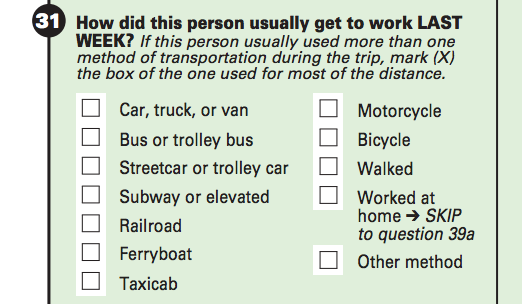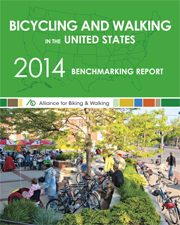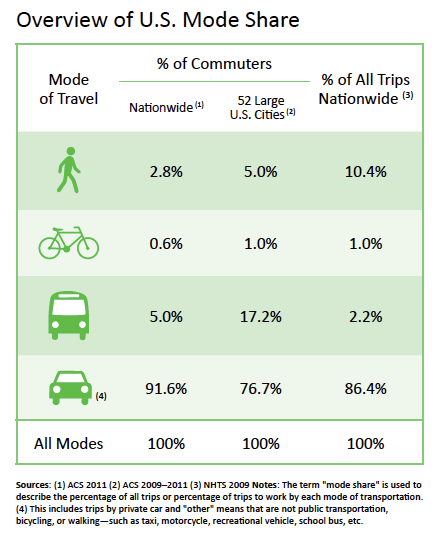The American Community Survey (ACS), which is performed every year on a small percentage of the U.S. population, has one question that makes it especially important to biking and walking advocates:

Source: US Census
The ACS asks how you usually got to work last week. Many options are presented, including "Car, truck, or van," "Bus or trolley bus," "Subway or elevated," "Bicycle," and "Walked." The question also asks that if you used more than one form of transportation last week, you choose the one that you used the most often.
This question is both wonderful and heartbreaking for biking and walking advocates.
 |
| Buy a copy of the 2014 Benchmarking Report |
It's wonderful because it gives advocates and government officials reliable estimates every single year about what proportion of people bike and walk to work in states and communities all across the United States.
Thanks to ACS data, we're able to compile a veritable treasure trove of vital information about biking and walking. In the 2014 Benchmarking Report, we show which cities have the highest levels of biking and walking to work (Portlanders win for biking; Bostonians walk most); analyze how a city's fatality rate relates to its rate of biking and walking to work (there's a strong reverse correlation); and analyze how levels of biking and walking in the US are changing over time (it's gradually increasing).
In short, the commute question from the annual American Community Survey is currently one of the most reliable sources of data on biking and walking.
But the question also breaks advocates' hearts, because it significantly undercounts bicycling and walking.
The first and most obvious reason is that the ACS only asks about trips to work. Anyone who doesn't travel to work on a daily basis – little kids, seniors, telecommuters – is automatically excluded. And because work commutes only represent a small portion of all trips, the ACS tells us about a very small fraction of all of the transporting that Americans do.
Another clear reason that the ACS underreports biking and walking is that the commute question asks respondents to choose only one mode of transportation. If a respondent walked to a bus stop in the last week, she'll be counted as a transit-taker but not a walker. If she bicycled on two days and drove on the other three days, she'll be counted as a driver but not a biker.
The single-mode requirement flattens the reality of our everyday transportation choices. We're multimodal beings, especially in a community where we're presented with a diversity of transportation choices. No one is just a driver or just a pedestrian or just a bicyclist – we all use some mix of modes get around, even if that only means being a pedestrian from your parking spot to the grocery store entrance.
 We have hard data to show that the ACS's commute question underreports biking and walking trips, thanks to another transportation survey, the National Household Travel Study (NHTS). Unlike the ACS, the NHTS asks respondents about all the trips they take – work trips, leisure trips, shopping trips, you name it.
We have hard data to show that the ACS's commute question underreports biking and walking trips, thanks to another transportation survey, the National Household Travel Study (NHTS). Unlike the ACS, the NHTS asks respondents about all the trips they take – work trips, leisure trips, shopping trips, you name it.
The NHTS methodology includes a brief phone survey that gathers basic demographic information and asks the person if he or she is willing to keep a travel diary for a day to record all trips by members of the household, including children. Travel diaries are mailed to the household, and NHTS officials follow up to answer any questions. Survey participants then receive a follow-up call from NHTS to collect information from the travel diary. They are asked a number of questions on their travel behavior during their assigned travel day and during the last week. NHTS respondents answer questions like how many times they went for a walk or bike ride, how long they spent bicycling or walking, and (if they drive) how many minutes it takes them to walk from where they park to their workplace.
Not surprisingly, national biking and walking numbers from the NHTS are much higher than their numerical counterparts from the ACS. The 2011 ACS reported that walking represents 2.8% of all trips to work nationwide; the 2009 NHTS countered that 10.4% of all trips are on foot. (See the graphic at right for more on the comparisons between these two surveys, or see the 2014 Benchmarking Report for more detail.)
But the National Household Travey Study isn't perfect, either. Unlike the ACS, the NHTS is administered irregularly (every 5 - 7 years) and its samples at the state and local level are too small to be reliable. This makes it nearly impossible to use the NHTS to examine data at the city level, like we do with the ACS.
When the Alliance compiles the Benchmarking Report, we aim to measure the biking and walking movement as accurate and completely as possible. We would love to have more accurate data in order to fulfill this mission more completely.
We're not the only ones. Because of the serious gap in reliable data on bicycling and walking trips, there have been numerous efforts to create a more reliable means to measure travel. Many cities perform their own counts to measure trips along various corridors or even to estimate bike modeshare more accurately across an entire city. But without a nationally standardized methodology for tracking modes of transportation at the city level, we won't be able to use those reports to compare cities or to track bicycling and walking nationally.
Nearly every Alliance Benchmarking Report has concluded with a plea for better data. Purchase a copy of the 2014 Report to take a deep dive into what our current data tell us and how we could make it better.
So thank you, American Community Survey, for being awesome. And, dagnabbit, we wish you were better!
Share this:
| Share on Facebook |

